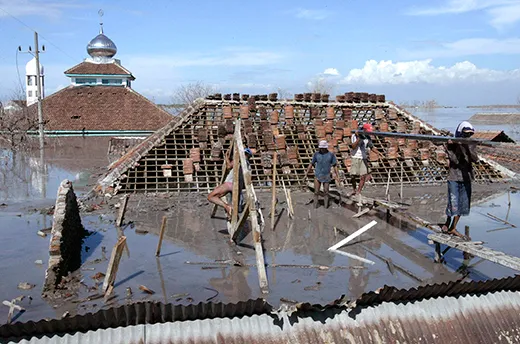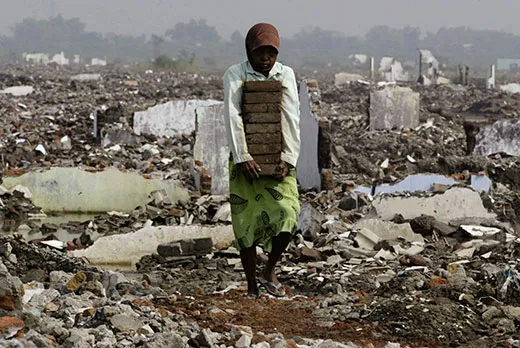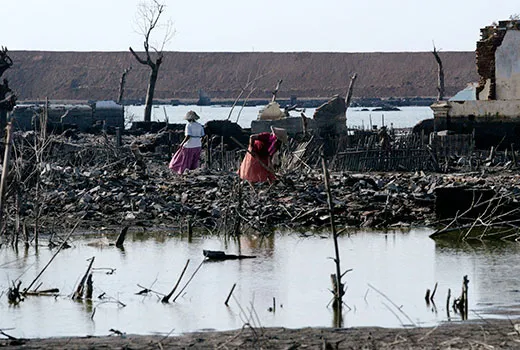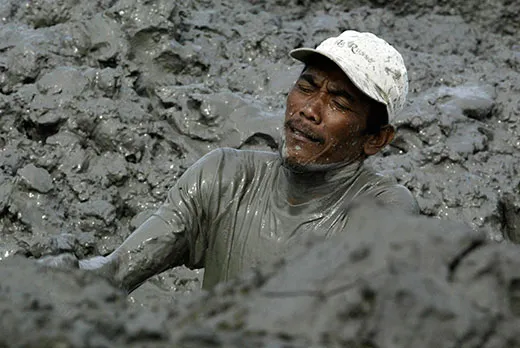The World’s Muddiest Disaster
Earth’s most violent mud volcano is wreaking havoc in Indonesia. Was drilling to blame? And when will it end?
/https://tf-cmsv2-smithsonianmag-media.s3.amazonaws.com/filer/mud-volcano-Indonesia-631.jpg)
The newest landmark in Indonesia is a spectacular disaster. On May 29, 2006, mud and steaming hot water squirted up in a rice field in Sidoarjo, East Java, marking the birth of the world’s most destructive mud volcano. Since then, the volcano, nicknamed Lusi (a contraction of the Indonesian word lumpur, meaning mud, and Sidoarjo), has erupted almost nonstop, engulfing an area more than twice the size of New York City’s Central Park and belching as much as six million cubic feet of muck—enough to fill 800 railroad boxcars—in a single day.
The ongoing disaster has displaced 13,000 families and closed 30 factories and hundreds of small businesses. Dozens of schools and mosques are buried in muck. Rice paddies and sugar cane plantations have been replaced by a brown expanse of cracked mud. A major toll road was inundated, and a gas pipeline exploded after it broke under the weight of Lusi’s outpouring, killing a dozen people.
The land surrounding the volcano’s main vent has started to sink because so much water and mud from beneath the ground have erupted and now weigh it down. New mud bubbles—smaller fissures where mud and gas escape to the surface—continue to pop up across the landscape. The price tag to contain the mess and compensate victims is more than half a billion dollars—and that number is rising.
But now, after more than five years, the mud volcano’s behavior appears to be changing; the nonstop eruptions have given way to more episodic spewing. Geologists are working to determine what that means for the future and how long Lusi will continue to ravage East Java.
“I think it’s good news,” says Richard Davies, a geologist at Durham University in England. “I think the worst is over in terms of the volume of mud coming up.”
Mud volcanoes are common in Indonesia. The humid climate provides an abundance of rain that washes sediments down the country’s numerous volcanic peaks, says Michael Manga, a geologist at the University of California at Berkeley. The wet sediments collect in low-lying areas and are rapidly buried by more and more debris eroding down from the mountains. The overlying sediments compress the lower layers, and pressure builds as the upper layers get thicker and heavier, and the squeezed water has nowhere to go. If a path to the surface opens, the highly pressurized water will shoot up like water from a fire hydrant and bring subsurface sediments with it.
Lusi is an unusual mud volcano for several reasons, including its long eruption period—most mud volcanoes erupt for only a few days at a time. It’s also unique because it’s the first mud volcano that scientists have observed from day one. Oil and natural gas exploration is common in East Java, and researchers have used subsurface data collected from a nearby exploration well to learn more about Lusi’s origins and behavior. It’s “the first time ever you know exactly what the subsurface was like prior to an eruption,” says Manga. “That’s kind of cool.”
But that same well may be to blame for the disaster. The day before the eruption began, the Indonesian company PT Lapindo Brantas removed a drill from the exploration well and experienced a “kick,” or influx of water into the well’s borehole, which cracked the surrounding rock. The next day, just 650 feet away, Lusi erupted.
Many geologists, including Manga and Davies, say drilling unleashed Lusi. Others, including geologist Adriano Mazzini of the University of Oslo, think a magnitude-6.3 earthquake centered 155 miles southwest of Sidoarjo that struck two days before Lusi began reactivated a fault, allowing water and mud to spurt to the surface. In 2008, the issue was put to a vote at an international conference of petroleum geologists; 55 out of 74 attendees agreed drilling played some role in the birth of the mud volcano. Lapindo has paid hundreds of millions of dollars to the displaced and to mitigate further damage, according to the non-governmental organization Humanitus, despite its claim of no wrongdoing.
Geologists are now moving on from the debate over what caused the disaster. “The most important question isn’t who’s responsible but when is the eruption going to end,” Manga says. “It’s a billion-dollar question.”
This year, two research teams considered the question—and came to different conclusions. Manga and his colleagues reported in the journal Earth and Planetary Science Letters that there is a 50 percent chance Lusi will last more than 41 years and a 33 percent chance it will last more than 84 years. A team led by Davies had a slightly more optimistic outlook: It suggested in the Journal of the Geological Society of London that the mud volcano’s most likely total life span is 26 years.
In either case, more territory will be swallowed by mud. Further geological analyses might help Indonesian officials better manage the disaster and explain how the recent slowdown in Lusi’s eruptions fits in with the predictions.
The different results emerge from the way the teams modeled Lusi’s plumbing and driving forces. Davies’ team says the water propelling the eruption comes from a 15-million-year-old layer of rock that sits at least 2,000 feet beneath the erupting mud. Twenty-six years, Davies says, is an estimate of how long it will take for the water pressure to return to normal.
Manga’s team says water within the mud layer itself is fueling the eruption. “If we’re right, it’s not typical of most mud volcanoes,” Manga says. Lusi is acting like a can of fizzy soda, he says, with bubbles of carbon dioxide and methane helping bring mud to the surface.
The mud volcano’s recent changes in activity may signal that the mechanism driving the eruption has changed, Davies says, but it’s not yet clear what they mean for the long-term outlook.
This year, scientists who study the eruption met in Indonesia for a conference and to observe the volcano. Instead of belching continuously, Lusi seemed to be “pulsing” every few minutes, Davies says. “It’s a bit like Old Faithful.” It’s also spewing less mud, adds Max Rudolph, a graduate student at UC-Berkeley. At a rate of about 530,000 cubic feet per day, he says, “the current eruption rate is [down by] a factor of 10 or more from its peak in 2006.”
Does this mean Lusi is quieting down for good, or just taking a break before ramping up again? Nobody knows for sure. It “made me realize we need to constantly re-evaluate the longevity estimates,” Davies says.
Getting a good estimate of Lusi’s life span is one reason why Humanitus, an education and community development organization based in Australia, organized the conference. After watching a documentary about the mud volcano, Humanitus Executive Director Jeffrey Richards says, he realized that “no one seemed to be looking at the future.” The controversy over the eruption’s cause was overshadowing the disaster, he says. “It has made it difficult for the government to get any sort of international assistance, which is normally the case for any disaster on that scale.”
Ironically, Lusi may offer ways to fix the area’s damaged economy. Businesses could use the heap of mud to make bricks and other construction materials, Richards says, and the mud volcano could even become a tourist destination. After years of coping with the hardships created by the disaster, the people of Sidoarjo “need some good positives to start coming out of this,” Richards says. As he and other scientists at the conference suggest, “It’s time to look at Lusi as a positive for this region.”
/https://tf-cmsv2-smithsonianmag-media.s3.amazonaws.com/accounts/headshot/science-erin-wyman-240.jpg)





/https://tf-cmsv2-smithsonianmag-media.s3.amazonaws.com/accounts/headshot/science-erin-wyman-240.jpg)